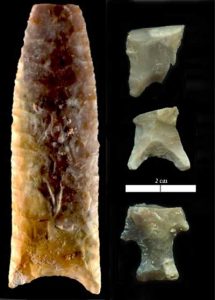Excavations of a known Gault site in Texas revealed layers of artefacts older than the previously discovered, containing traces of human occupation, dating back even 16700 years. So far over 90 stone tools were documented. The artefacts, being some of the oldest yet found in American West, are rare traces of a culture that pre-dated the culture known as Clovis, who is believed to be the continent’s first human inhabitants. This discovery adds up to other evidence that humans arrived on the continent longer ago than was once thought.

The Gault site was discovered in 1920s but discoveries of first tools were made in 1990s. New works at the site started in 2002 led by Dr. D. Clark Wernecke, director of the Gault School of Archaeological Research. Since that time the team concentrated the effort on two parts of the site. The first one, Area 12, revealed an unusual “pavement” constructed out of cobbles buried deep beneath the surface. It measures roughly two-by-three-meter forming a rectangular gravel pad about 10 centimetres thick of rounded river gravels in a narrow range of sizes, with artefacts of at least Clovis age on and around it. About 1 metre below the pavement and Clovis tools nine more flakes of shaped stone, along with a scattering of animal bones were found.

At a nearby Area 15, the researchers first found a few more stone tools fashioned in the signature Clovis style. But several centimetres below that, an abundance of new material appeared — including human teeth on form of enamel caps of four adjacent teeth from a young adult female. Even deeper more than 90 stone tools were discovered, fashioned in a style that clearly wasn’t Clovis due to different morphology. In addition to the 90 tools, the artefacts include more than 160000 stone flakes left over from the tool-making process, being also different than flakes found with Clovis tools.

The results of optically stimulated luminescence dating of 18 of the artefacts resulted in dating the artefacts as being between 13200 to 16700 years old. The diversity of artefacts uncovered at the Gault site also shows that the continent’s earliest peoples were not a static or monolithic group.
(after Western Digs)